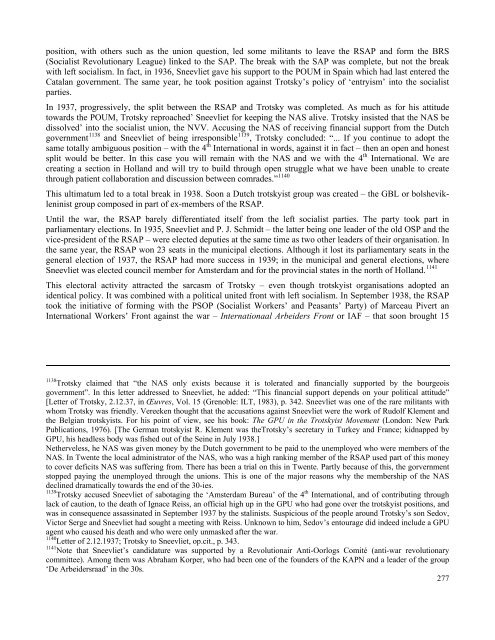The German-Dutch Communist Left - Libcom
The German-Dutch Communist Left - Libcom
The German-Dutch Communist Left - Libcom
You also want an ePaper? Increase the reach of your titles
YUMPU automatically turns print PDFs into web optimized ePapers that Google loves.
position, with others such as the union question, led some militants to leave the RSAP and form the BRS<br />
(Socialist Revolutionary League) linked to the SAP. <strong>The</strong> break with the SAP was complete, but not the break<br />
with left socialism. In fact, in 1936, Sneevliet gave his support to the POUM in Spain which had last entered the<br />
Catalan government. <strong>The</strong> same year, he took position against Trotsky’s policy of ‘entryism’ into the socialist<br />
parties.<br />
In 1937, progressively, the split between the RSAP and Trotsky was completed. As much as for his attitude<br />
towards the POUM, Trotsky reproached’ Sneevliet for keeping the NAS alive. Trotsky insisted that the NAS be<br />
dissolved’ into the socialist union, the NVV. Accusing the NAS of receiving financial support from the <strong>Dutch</strong><br />
government 1138 and Sneevliet of being irresponsible 1139 , Trotsky concluded: “... If you continue to adopt the<br />
same totally ambiguous position – with the 4 th International in words, against it in fact – then an open and honest<br />
split would be better. In this case you will remain with the NAS and we with the 4 th International. We are<br />
creating a section in Holland and will try to build through open struggle what we have been unable to create<br />
through patient collaboration and discussion between comrades.” 1140<br />
This ultimatum led to a total break in 1938. Soon a <strong>Dutch</strong> trotskyist group was created – the GBL or bolshevikleninist<br />
group composed in part of ex-members of the RSAP.<br />
Until the war, the RSAP barely differentiated itself from the left socialist parties. <strong>The</strong> party took part in<br />
parliamentary elections. In 1935, Sneevliet and P. J. Schmidt – the latter being one leader of the old OSP and the<br />
vice-president of the RSAP – were elected deputies at the same time as two other leaders of their organisation. In<br />
the same year, the RSAP won 23 seats in the municipal elections. Although it lost its parliamentary seats in the<br />
general election of 1937, the RSAP had more success in 1939; in the municipal and general elections, where<br />
Sneevliet was elected council member for Amsterdam and for the provincial states in the north of Holland. 1141<br />
This electoral activity attracted the sarcasm of Trotsky – even though trotskyist organisations adopted an<br />
identical policy. It was combined with a political united front with left socialism. In September 1938, the RSAP<br />
took the initiative of forming with the PSOP (Socialist Workers’ and Peasants’ Party) of Marceau Pivert an<br />
International Workers’ Front against the war – Internationaal Arbeiders Front or IAF – that soon brought 15<br />
1138 Trotsky claimed that “the NAS only exists because it is tolerated and financially supported by the bourgeois<br />
government”. In this letter addressed to Sneevliet, he added: “This financial support depends on your political attitude”<br />
[Letter of Trotsky, 2.12.37, in Œuvres, Vol. 15 (Grenoble: ILT, 1983), p. 342. Sneevliet was one of the rare militants with<br />
whom Trotsky was friendly. Vereeken thought that the accusations against Sneevliet were the work of Rudolf Klement and<br />
the Belgian trotskyists. For his point of view, see his book: <strong>The</strong> GPU in the Trotskyist Movement (London: New Park<br />
Publications, 1976). [<strong>The</strong> <strong>German</strong> trotskyist R. Klement was theTrotsky’s secretary in Turkey and France; kidnapped by<br />
GPU, his headless body was fished out of the Seine in July 1938.]<br />
Netherveless, he NAS was given money by the <strong>Dutch</strong> government to be paid to the unemployed who were members of the<br />
NAS. In Twente the local administrator of the NAS, who was a high ranking member of the RSAP used part of this money<br />
to cover deficits NAS was suffering from. <strong>The</strong>re has been a trial on this in Twente. Partly because of this, the gorvernment<br />
stopped paying the unemployed through the unions. This is one of the major reasons why the membership of the NAS<br />
declined dramatically towards the end of the 30-ies.<br />
1139 Trotsky accused Sneevliet of sabotaging the ‘Amsterdam Bureau’ of the 4 th International, and of contributing through<br />
lack of caution, to the death of Ignace Reiss, an official high up in the GPU who had gone over the trotskyist positions, and<br />
was in consequence assassinated in September 1937 by the stalinists. Suspicious of the people around Trotsky’s son Sedov,<br />
Victor Serge and Sneevliet had sought a meeting with Reiss. Unknown to him, Sedov’s entourage did indeed include a GPU<br />
agent who caused his death and who were only unmasked after the war.<br />
1140 Letter of 2.12.1937; Trotsky to Sneevliet, op.cit., p. 343.<br />
1141 Note that Sneevliet’s candidature was supported by a Revolutionair Anti-Oorlogs Comité (anti-war revolutionary<br />
committee). Among them was Abraham Korper, who had been one of the founders of the KAPN and a leader of the group<br />
‘De Arbeidersraad’ in the 30s.<br />
277
















